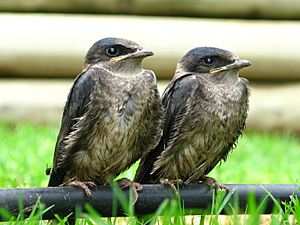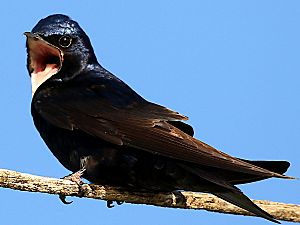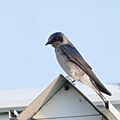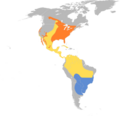Purple martin facts for kids
Quick facts for kids Purple martin |
|
|---|---|
 |
|
| Adult male | |
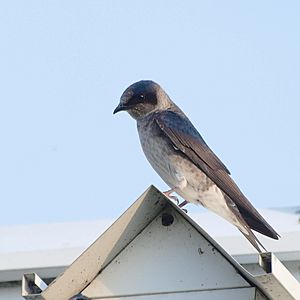 |
|
| Adult female | |
| Conservation status | |
| Scientific classification | |
| Genus: |
Progne
|
| Species: |
subis
|
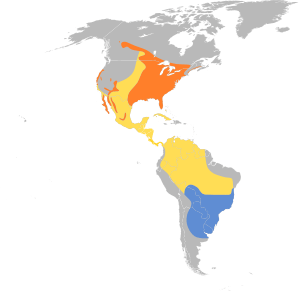 |
|
| Synonyms | |
|
|
The purple martin (Progne subis) is the biggest type of swallow found in North America. Even though they are called "purple," their feathers are not truly purple. Instead, they are a dark bluish-black. This color looks bright blue, navy blue, or deep purple because of how light bounces off their feathers. Sometimes, they can even look green!
These birds are known for being fast and agile flyers. They often mix quick flapping with smooth gliding. When they fly towards their nests, they can dive from the sky very quickly with their wings pulled in close.
Contents
What are Purple Martins Like?
Purple martins are a type of swallow. They are the largest birds in the swallow family, called Hirundinidae. They are about 20 centimeters (8 inches) long. Their wings can spread up to 38 centimeters (15 inches) wide.
Here are some average measurements for purple martins:
- Length: 19-20 cm (7.5-7.9 in)
- Weight: 45-60 g (1.6-2.1 oz)
- Wingspan: 39-41 cm (15.3-16.1 in)
Male and female purple martins look different. This is called sexual dimorphism. Adult males are completely black with a shiny, steel-blue color. They are the only swallows in North America that are all black. Adult females are dark on top with a bit of the steel-blue shine. Their undersides are lighter. Both males and females have a slightly forked tail.
Young purple martins take two years to get their full adult feathers. This is called delayed plumage maturation. Young females look like adult females but are browner and do not have the steel-blue shine. Young males look a lot like females. However, black feathers start to appear on their chests in patches as they grow into their adult look.
Where Do Purple Martins Live?
Purple martins breed across North America. They like open areas in eastern North America. They also live in some places on the west coast, from British Columbia down to Mexico.
Martins build their nests in holes or cavities. These can be natural holes, like old woodpecker nests in trees or large cacti. But in many places, especially in the eastern United States, people put up special houses or hollow gourds for them. This means these birds often live in colonies close to people, even in towns and cities. If there are no human-made nests, you usually won't find them there.
When winter comes, purple martins fly south. They migrate all the way to the Amazon basin in South America. Their winter homes reach into Ecuador.
Conservation and Humans
Purple martins faced a big drop in their numbers during the 1900s. This was mainly because of European starlings and house sparrows. These birds were brought to North America and compete with martins for nesting spots. Starlings and sparrows are very aggressive. They will often fight martins, sometimes even killing adult martins, to take over their nests. They might also remove eggs or young birds.
Even though purple martins are listed as "least concern" by conservation groups, they face a special problem. Almost all purple martins in eastern North America now nest only in human-made houses or gourds. Fewer people are putting up and taking care of these nesting sites. One study found that most people who provide homes for martins are 50 years old or older. Younger people are not showing the same interest or do not have the resources to help.
Helping Purple Martins
Purple martins are considered synanthropic. This means they have learned to live near humans and benefit from it. Over many years, the eastern purple martins have completely changed. They used to nest in the wild, but now they rely on humans to provide their homes.
Once a colony of purple martins starts in a new place, it usually stays there. This is as long as nesting spots are available. Martins are very loyal to their nesting sites. If they successfully raise young in a spot, they will often come back to the same place year after year.
People have helped purple martins for a long time. Even before European settlers arrived, Native American tribes like the Cherokee, Chickasaw, and Choctaw hung out hollow gourds for them. They did this because the martins would eat thousands of insects that might otherwise harm their crops.
It is important to keep taking care of purple martin houses. This is because European starlings and house sparrows will try to take over the nests. If the houses are not watched, these more aggressive birds will often move in. Many people believe that purple martins would disappear from eastern North America without this help from humans.
Purple Martin Behavior
Migration
Purple martins spend their winters in Brazil, Bolivia, and parts of Peru. In the spring, they fly north to North America to breed. The birds arrive at different times. They show up in southern areas like Florida and Texas in January. But they might not reach the northern United States until April, and Canada until May.
Older birds usually arrive at the breeding grounds first. This is because they want to get the best nesting spots. Older males often leave their winter homes in late December or early January. Older females follow them. Younger birds, those in their first year, usually arrive up to two months later.
The trip south in the fall also happens at different times. Some birds leave as early as July, while others stay until October. Martins usually fly over land, through Mexico and Central America. When they are not breeding, martins gather in very large groups. They roost (sleep) together in huge numbers. This starts just before they fly south and continues in their winter homes.
These groups can be so big that when they fly out from their roosts to find food, their movement can be seen on weather radar! These are called roost rings. They start small and get bigger as the birds spread out, until the ring disappears.
Life Cycle and Breeding

Male purple martins arrive at the breeding sites before the females. They choose their territory. A territory can include several possible nest spots. After a male and female form a pair, they both look at the available nest sites.
The nest is built inside the cavity of a human-made house or gourd. It looks somewhat flat. The nest usually has three layers. The bottom layer is a base made of twigs, mud, and small pebbles. Sometimes, even small shells are used. The middle layer is made of grasses and finer twigs. The top layer is a small dip, often lined with fresh green leaves, where the eggs are laid.
Purple martins usually raise only one group of young each year. A female lays about four to six eggs in a nest. She lays one egg each day. The female is the main one who sits on the eggs to keep them warm, with some help from the male. This is called incubation. Incubation lasts for 15–16 days. The eggs hatch over two to three days.
The young birds leave the nest, or fledge, when they are between 26 and 32 days old. Even after they fledge, their parents will continue to feed and care for them for up to a month.
What Do Purple Martins Eat?
Purple martins are insectivores, meaning they eat insects. They mostly catch insects while flying in the air. This is called hawking. These birds are very good at hunting and eat many different kinds of winged insects. They rarely land on the ground to eat insects.
They usually fly quite high. So, even though many people think they eat lots of mosquitoes, mosquitoes are not a big part of their diet. However, a study from 2015 showed that purple martins do eat invasive fire ants (Solenopsis invicta). These ants might make up a good portion of their food.
Sounds and Calls
Purple martins are very noisy birds! They make many different sounds, like chirps, chortles, rattles, and croaks.
Their calls are described as "throaty and rich." Some sounds they make are tchew-wew, pew pew, choo, cher, zweet, and zwrack. Male martins have a special gurgling song they use to attract a mate. They also have a "dawn song" they sing early in the morning.
Sometimes, recordings of purple martin songs are sold. People use these tapes to attract martins to new birdhouses they put up.
Images for kids
See also
 In Spanish: Golondrina purpúrea para niños
In Spanish: Golondrina purpúrea para niños



